How to Properly Clean and Sterilize a Menstrual Cup
Caring for Your Menstrual Cup: Learn how to wash and sanitize your menstrual cup effectively with this comprehensive guide. Discover essential tips for maintaining hygiene, prolonging cup life, and ensuring a comfortable and eco-friendly period.
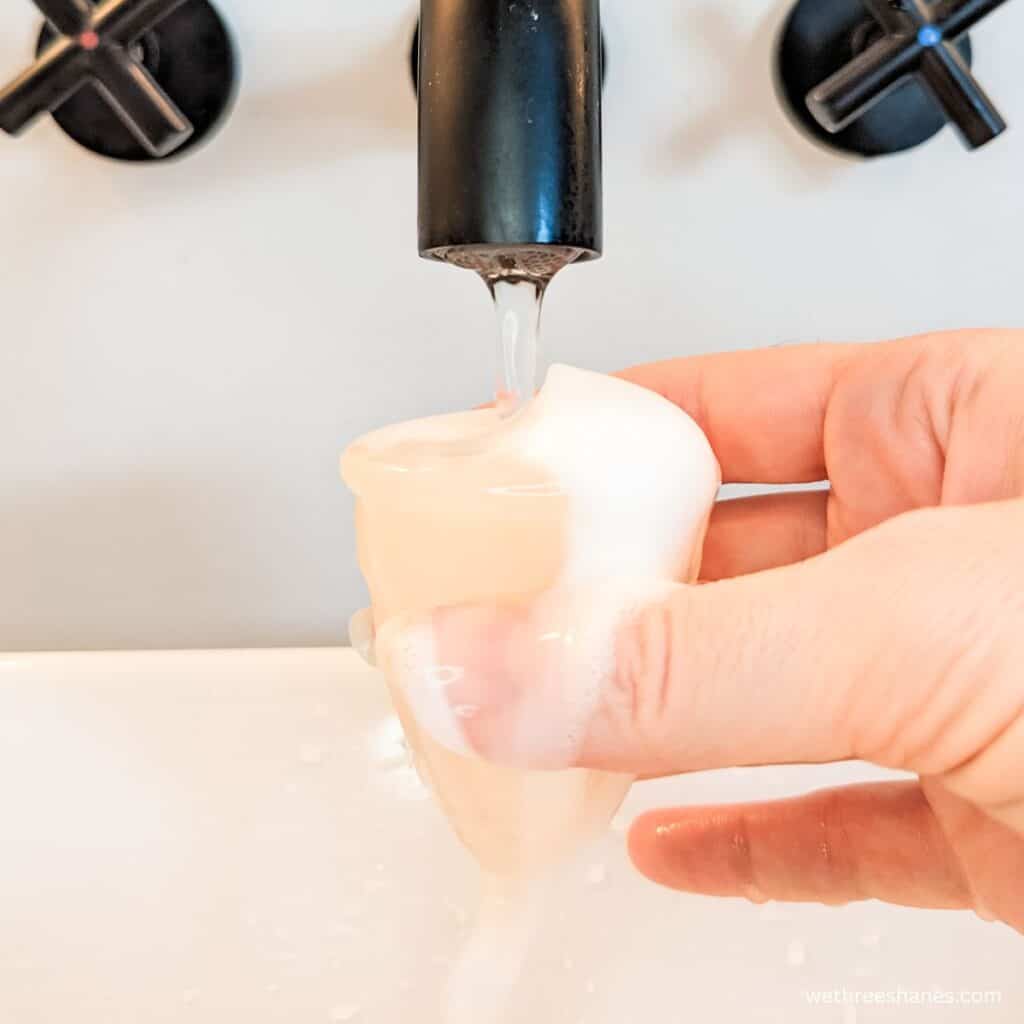
(THIS POST PROBABLY CONTAINS AFFILIATE LINKS. OUR FULL DISCLOSURE POLICY IS LONG & BORING BUT, YOU CAN FIND IT HERE.)
Menstrual Cup Care Guide
Learning the right care for a menstrual cup and understanding the importance of proper cleaning is essential for maintaining good hygiene, reducing the risk of infections, and ensuring the cup’s safe and effective use.
Cleaning a menstrual cup involves thorough washing with mild, unscented soap and clean water between uses, as well as sterilization between periods to prevent the growth of harmful bacteria. Proper cleaning not only keeps the cup free from odors and stains but also reduces the risk of infection and prolongs the cup’s lifespan, making it a sustainable and cost-effective choice for menstrual hygiene.
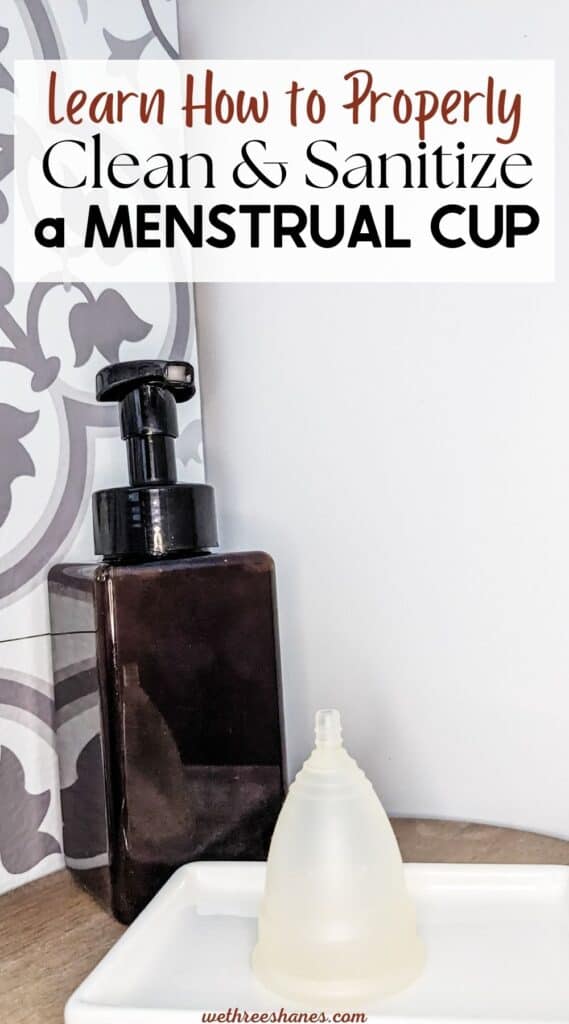
What is a Menstrual Cup
A menstrual cup is a reusable feminine hygiene product designed to collect menstrual blood during a person’s period. It is typically made of medical-grade silicone, rubber, latex, elastomer, or TPE (thermoplastic elastomer). The cup is bell-shaped with a stem or grip for easy insertion and removal.
Menstrual cups come in various sizes and shapes to accommodate different body types, ages, and flow levels. Choosing the right size and brand may involve some trial and error to find what works best for you.
Some key advantages of menstrual cups include their eco-friendliness, cost-effectiveness, extended wear time, and reduced risk of leaks compared to tampons or pads. However, it may take some practice to learn how to use them correctly, and not everyone may find them suitable for their needs or preferences. It’s important to consult with a healthcare provider or seek advice from experienced users if you have questions or concerns about using a menstrual cup.
Before First Use
Boiling your menstrual cup before the first use is an important step to ensure its cleanliness, hygiene, and safety. There are several reasons why boiling your menstrual cup before initial use is recommended:
- Sterilization: The manufacturing and packaging process may introduce germs or contaminants to the menstrual cup. Boiling it helps to sterilize the cup, eliminating any potential bacteria, microbes, or pathogens that could cause infection or irritation when the cup is inserted.
- Removal of Residues: Boiling the cup can remove any residues from the manufacturing process, such as dust, oils, or other substances that may be present on the cup’s surface.
- Odor Removal: Some menstrual cups can have a slight odor from the materials used during production. Boiling can help eliminate any unwanted odors, leaving the cup fresh and odor-free.
- Activation of Silicone: Boiling can help activate the silicone material and make the cup softer and more pliable. This can improve comfort and ease of insertion.
It’s essential to follow the specific care and cleaning instructions provided by the manufacturer of your menstrual cup. Over-boiling or using harsh chemicals can damage the cup, so it’s important to be gentle and follow their recommended time.
Boiling Tips
Most companies recommend boiling your cup for 5-10 mins.
The best way to keep the cup from hitting the bottom of the pot is to place the cup in a wire whisk before placing it in the boiling water.
Set a timer so you don’t over-boil your cup which can result in damage.
Allow the cup to cool down to room temperature before using or storing it.
It’s important to note that boiling should be done only before the first use and occasionally between menstrual cycles for ongoing sterilization. During your period, simply wash your menstrual cup with warm water and mild soap to keep it clean between uses.
Cleaning Your Cup During Your Period
Here are the general steps for washing a period cup when in use:
1. Wash your hands in warm water before removing your menstrual cup to maintain hygiene.
2. Remove the cup and hold it over the toilet bowl and empty its contents.
3. Rinse the cup with hot water to remove any remaining menstrual fluid.
4. If you’re near a sink, wash the cup with a mild, unscented, water-based soap if possible. Be sure to clean all the creases, air holes, and folds. You can also use a designated menstrual cup cleanser if you prefer but it’s really not necessary.
5. After cleaning, rinse the cup thoroughly with water to ensure no soap residue remains.
6. Once the cup is clean and rinsed, it ready for the next use. You can now reinsert it.
Again, it’s always a good idea to follow the manufacturer’s instructions for cleaning and caring for your specific menstrual cup so read those carefully when you first get your reusable menstrual cup.
However, following the above steps is pretty standard practice so don’t feel like you have to keep that manual for eternity. You’ll get the hang of proper cleaning after a couple of uses.
How to Clean Your Cup in a Public Bathroom
Cleaning your menstrual cup in a public restroom can be a bit challenging since you may not have access to a private public toilet or the convenience of your regular cleaning routine. However, there are a few discreet and sanitary methods you can use to clean your menstrual cup when you’re out:
1. Use a portable bottle of water: Finding a single room bathroom with a sink isn’t always possible when you’re out and about so carrying bottled water is a must when changing your cup in public. Carry a small, discreet bottle of water with you. When you need to empty and clean your cup, use the water to rinse it over a toilet. It will be cold water and that’s okay. You can always give your cups an extra rinse at the next convenient time.
2. Use a Menstrual cup wipe: Some brands offer specialized menstrual cup cleaning wipes that are compact and easy to carry in your bag. These wipes are designed for cleaning your cup when you’re on the go.
3. Clean toilet paper: You can use dampened toilet paper to clean your menstrual cup. Be sure to wipe it thoroughly to remove any residual blood. Then flush the toilet paper when done.
4. Carry a spare cup: If it’s possible, consider carrying a spare, pre-sanitized menstrual cup with you. This way, you can simply switch out the dirty cup for a clean one without needing to clean it in public. Wrap the used cup in clean tissue. paper towel, or toilet paper and then clean it when you get home.
5. Hand sanitizer: You can use a small amount of alcohol-based hand sanitizer on your hands to clean them before handling your cup. While this doesn’t clean the cup itself, it helps ensure your hands are as clean as possible when inserting or removing it.
Remember to wash your cup with soap and water as soon as you have access to a private bathroom to ensure it’s properly cleaned and sanitized.
If you’re in a situation where you can’t clean it immediately, try to use one of the methods mentioned above to make it as sanitary as possible until you can do a thorough cleaning. Always carry spare menstrual products and backup supplies, just in case.
How to Clean a Stained Menstrual Cup
Slight discoloration is normal even when using proper cleaning techniques but you might want to remove stains from time to time. However, this is not something you need to do on a regular basis.
If your menstrual cup has become stained then you want to use hydrogen peroxide to help remove the stains. Mix 3% hydrogen peroxide, found at most drug stores, with equal parts water in a cup or small container. You just need enough to fully submerge your cup.
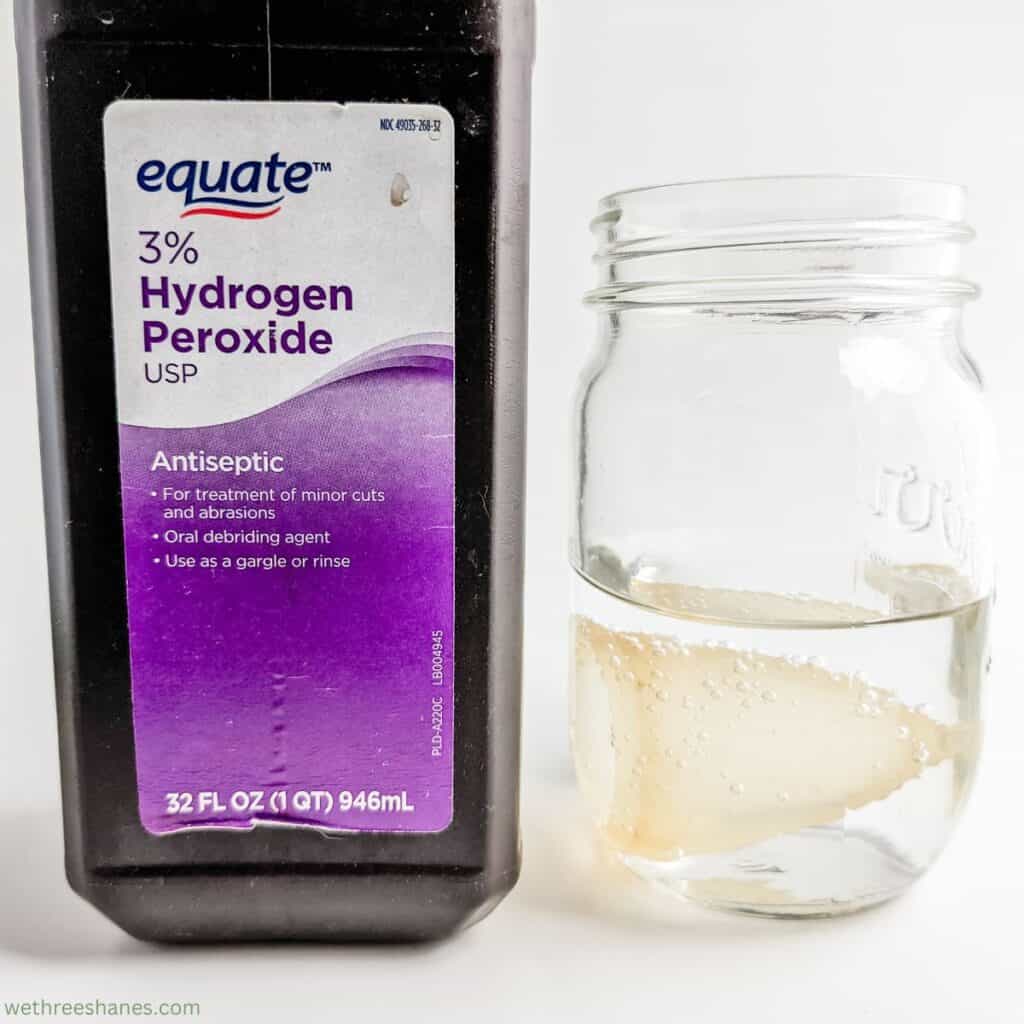
Allow the cup to sit for at least a couple hours to over night. This will help break down the menstrual cup stains. Once you’re done soaking you need to rinse the cup with soap and water and then sterilize it using the steps below.
It’s important to note that while hydrogen peroxide can be effective in removing stains, it should be used with caution and in the recommended 3% concentration. Do not use stronger concentrations of hydrogen peroxide, bleach, or harmful chemicals, as they can damage the cup.
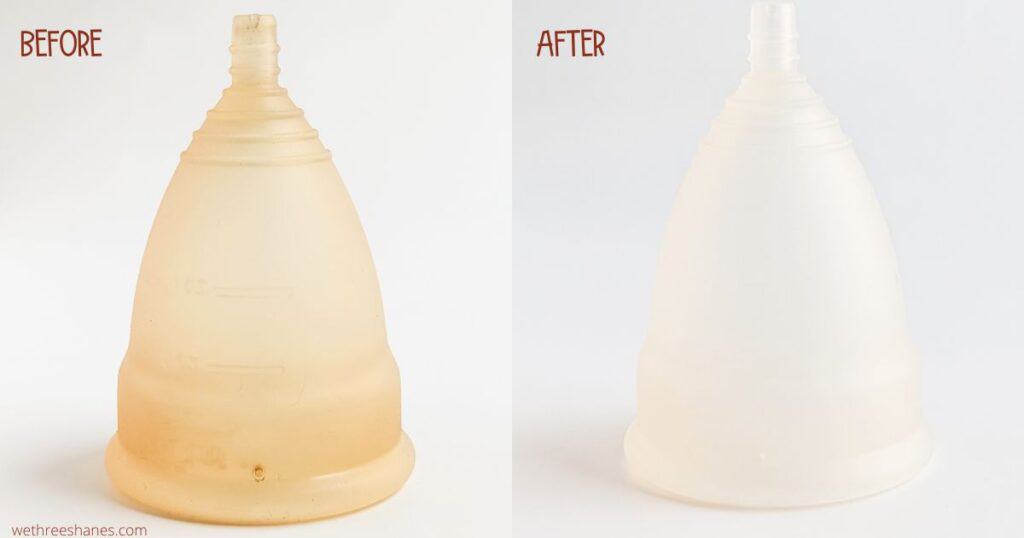
Sterilizing Your Cup After Your Period
Sterilizing a menstrual cup after your period is important to ensure it’s clean and safe for future use.
Different people have different ick factors when it comes to a sterilizing a menstrual cup. Some think it’s gross to put it in a pot while other’s think it’s gross to put it in the microwave. Good thing you have options. Read them over and choose the best one for you.
Boiling Water Method
Basically, the same boiling method as the before use method:
- Boil a pot of water and carefully place your menstrual cup in it.
- Let it boil for 5-10 minutes.
- Use tongs or a clean utensil to remove the cup from the boiling water.
- Allow it to cool before using or storing.
Microwave Method
- Place your menstrual cup in a microwave-safe container.
- Fill the container with water until the cup is fully submerged.
- Microwave on high for 2-3 minutes.
- Use caution when removing the container from the microwave as it will be hot.
You can use a sterilizing cup that’s made for using in the microwave or can be filled with boiling water without the use of the microwave. I personally think using one is the easiest option and it collapses for easy storing.
Sterilizing Powder
Purchase specially designed menstrual cup sterilizing powder packets. You just pour the powder in warm water and then let the cup soak for 15 minutes or so.
Follow the manufacturer’s instructions for dilution and soaking time.
Menstrual Cup Steamers
Some brands offer menstrual cup steamers designed specifically for sterilizing purposes. These devices use steam to sterilize the cup quickly and effectively.
They are easy to use and can be used for sterilizing other small objects as well. But, it does take up a small amount of space.
UV-C Sterilizer
A UV sterilizer gets rid of 99% of germs in just two minutes. Using a sterilizer will help prolong the life of your cup because it’s not as harsh as the boiling method.
Remember to regularly check your menstrual cup for signs of wear and tear, such as cracks or deterioration, and replace it as needed to ensure your safety and comfort during your period.
How to Store Your Menstrual Cup
Storing your menstrual cup properly is important to maintain its hygiene and longevity. Here are some tips on the best ways to store a menstrual cup:
1. Use a breathable container – Most menstrual cups come with a cotton bag for storage. The breathable material allows for air circulation, which helps prevent the growth of bacteria and keeps the cup dry between uses.
2. Keep it clean – Before storing your menstrual cup, make sure it’s clean and completely dry. Wash it thoroughly with mild, unscented, and non-antibacterial soap, rinse it well, and pat it dry with a clean, lint-free cloth or paper towel.
3. Avoid airtight containers – Do not store your menstrual cup in an airtight container or plastic bag that doesn’t allow for airflow. Storing it in an airtight environment can trap moisture, which may lead to the growth of mold or bacteria.
4. Store in a cool, dry place – Find a clean, dry, and cool place to store your menstrual cup. Avoid direct sunlight and high temperatures, as excessive heat can damage the cup or cause it to lose its shape.
5. Check periodically – Periodically inspect your menstrual cup for any signs of wear, tears, or deterioration. If you notice any damage, it’s best to replace it with a new one.
6. Keep it out of the reach of pets and children – Store your menstrual cup in a location where it is not accessible to pets or young children to prevent any accidental tampering.
7. Carry a backup – If you’re on the go and need to store your menstrual cup temporarily, carry a small, breathable pouch or a resealable paper bag with you. This allows you to keep your cup clean and discreetly stored while you’re away from home.
By following these storage guidelines, you can ensure that your menstrual cup remains clean and in good condition until your next period. Remember that proper cleaning and storage are essential to maintain the cup’s hygiene and functionality.
Quick Questions You Might Have About Cleaning a Menstrual Cup
Do you need a menstrual cup cleaner?
No, you don’t necessarily need a menstrual cup cleaner. Mild, unscented, water-based soap and water are usually sufficient for cleaning.
Do I need to boil my menstrual cup every time?
Boiling your menstrual cup after every single use is not be necessary. You do need to wash it with gentle soap after each use.
Boiling the cup helps eliminate any potential bacteria or germs that could cause infections. However, boiling it after every use might not only be excessive but could also lead to the cup deteriorating faster due to prolonged exposure to high temperatures.
Here’s a general guideline for boiling your menstrual cup:
- Before first use: Before using your menstrual cup for the first time, it’s important to boil it for around 5-10 minutes to ensure it’s properly sterilized.
- Between cycles: At the end of your menstrual cycle, after you’ve thoroughly cleaned the cup with water and mild soap, you can boil it again for 5-10 minutes to prepare it for storage until your next cycle.
- As needed: If you find that your menstrual cup becomes discolored, has an odor, or you suspect it might be contaminated, you can boil it for a few minutes to help restore its cleanliness.
How often should I wash my menstrual cup?
Menstrual cup cleaning frequency depends on the individual’s flow and personal hygiene preferences. However, it’s generally recommended to empty and clean the menstrual cup at least every 8-12 hours. Here’s a basic guideline:
- Every 8-12 hours: Most menstrual cup manufacturers suggest emptying and cleaning the cup every 8 to 12 hours, similar to how often you’d change a tampon or pad. This ensures that the cup doesn’t become too full and minimizes the risk of leakage.
- Heavy flow: If you have a heavier flow, you might need to empty and clean the cup more frequently, possibly every 4-6 hours. This helps prevent overflow and discomfort.
Basically, you will need to wash your cup every time you empty it, before putting it back in. For a medium to light flow that will be twice a day. Once in the morning, assuming you slept with one inserted, and once again in the evening. If your flow is heavy then you’ll need to empty it more often and that will lead to more washes.
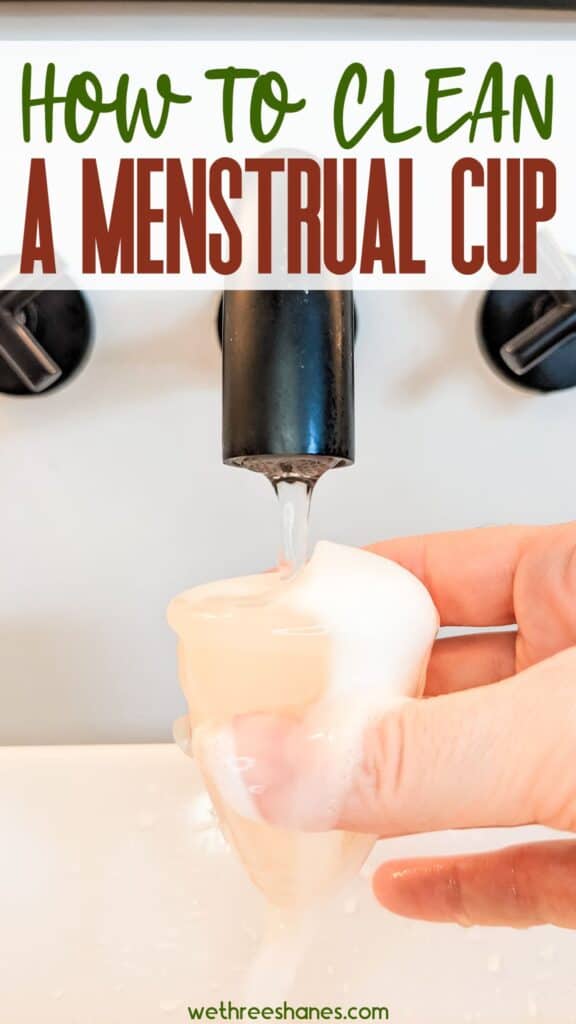
Proper Menstrual Cup Cleaning is Important
Knowing how to properly clean and sanitize a menstrual cup is essential for its safe and effective use. Proper cleaning not only ensures hygiene and comfort but also extends the life of the cup, making it an eco-friendly and cost-effective choice.
By following these recommended cleaning methods, including using warm water and mild soap for routine cleaning and boiling for sterilization, users can maintain the cleanliness and safety of their menstrual cups, contributing to a more sustainable and comfortable menstrual experience.




